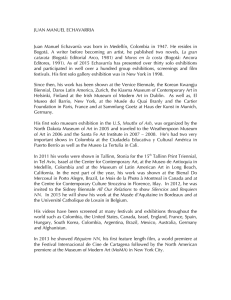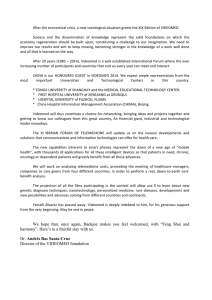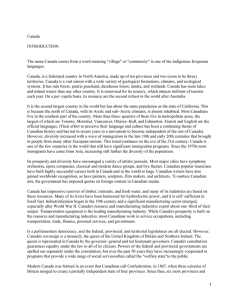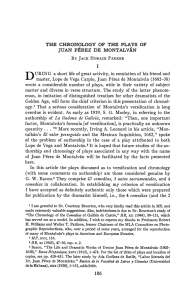History of the Royal Ontario Museum
Anuncio
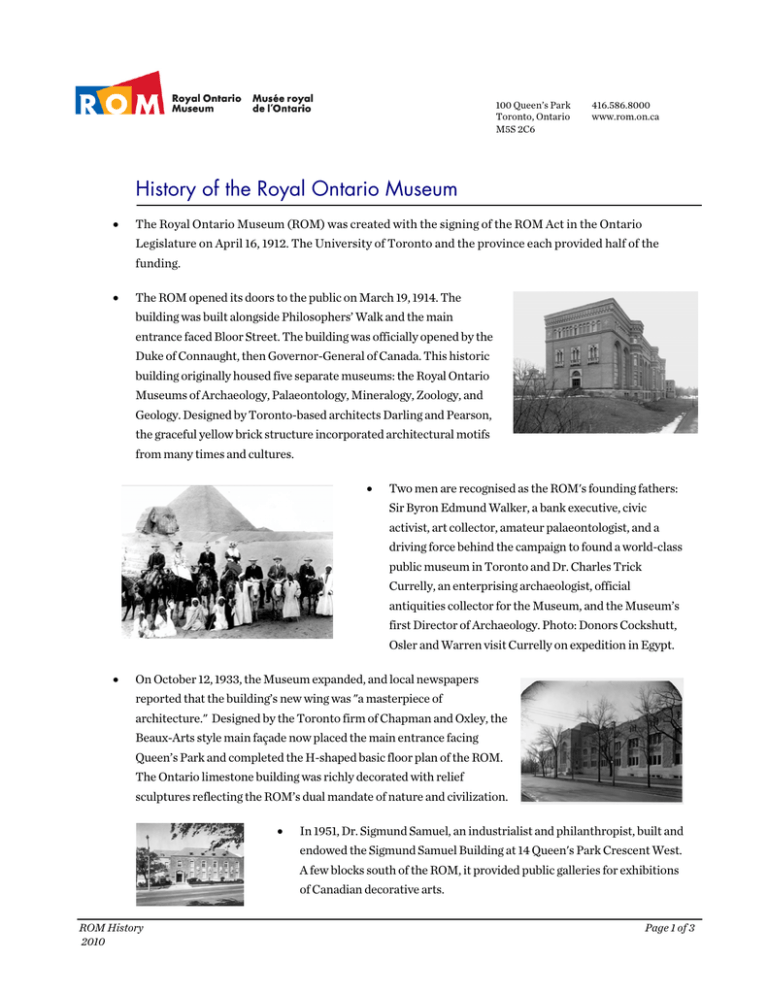
100 Queen’s Park Toronto, Ontario M5S 2C6 416.586.8000 www.rom.on.ca History of the Royal Ontario Museum • The Royal Ontario Museum (ROM) was created with the signing of the ROM Act in the Ontario Legislature on April 16, 1912. The University of Toronto and the province each provided half of the funding. • The ROM opened its doors to the public on March 19, 1914. The building was built alongside Philosophers’ Walk and the main entrance faced Bloor Street. The building was officially opened by the Duke of Connaught, then Governor-General of Canada. This historic building originally housed five separate museums: the Royal Ontario Museums of Archaeology, Palaeontology, Mineralogy, Zoology, and Geology. Designed by Toronto-based architects Darling and Pearson, the graceful yellow brick structure incorporated architectural motifs from many times and cultures. • Two men are recognised as the ROM's founding fathers: Sir Byron Edmund Walker, a bank executive, civic activist, art collector, amateur palaeontologist, and a driving force behind the campaign to found a world-class public museum in Toronto and Dr. Charles Trick Currelly, an enterprising archaeologist, official antiquities collector for the Museum, and the Museum’s first Director of Archaeology. Photo: Donors Cockshutt, Osler and Warren visit Currelly on expedition in Egypt. • On October 12, 1933, the Museum expanded, and local newspapers reported that the building’s new wing was "a masterpiece of architecture." Designed by the Toronto firm of Chapman and Oxley, the Beaux-Arts style main façade now placed the main entrance facing Queen’s Park and completed the H-shaped basic floor plan of the ROM. The Ontario limestone building was richly decorated with relief sculptures reflecting the ROM’s dual mandate of nature and civilization. • In 1951, Dr. Sigmund Samuel, an industrialist and philanthropist, built and endowed the Sigmund Samuel Building at 14 Queen's Park Crescent West. A few blocks south of the ROM, it provided public galleries for exhibitions of Canadian decorative arts. ROM History 2010 Page 1 of 3 • In 1955, the ROM’s five separate museums were unified to become a single museum under one museum Director. • In 1968, the ROM formally separated from the University of Toronto and became an agency under the Government of Ontario. • The McLaughlin Planetarium opened on October 26, 1968 as the result of a $2 million gift from Canadian automotive magnate Colonel R. Samuel McLaughlin. • In 1978, a $55 million renovation was undertaken to provide additional space for the ROM's expanding research activities and for collections storage. The ROM was closed from January 1980 to September 1982 while a new curatorial centre, library were built, and the new Queen Elizabeth Terrace Building was added for new gallery spaces. Toronto architect Gene Kinoshita won a Governor-General's Award for his design. • In 1987, the George R. Gardiner Museum of Ceramic Art, the first specialized museum of ceramics in North America, became associated with the ROM. In January 1997, the Gardiner Museum separated from the ROM based on a $15 million endowment made by George R. Gardiner, the museum’s founder. • On February 19, 1994, the ROM opened the Sigmund Samuel Canadiana Gallery on the Museum's new Canadian Heritage Floor. • In November 1995, the ROM closed the McLaughlin Planetarium. • In 1999, the ROM opened four new galleries: Discovery Gallery, Hands-On Biodiversity, Dynamic Earth: Inco Limited Gallery of Earth Sciences, and the Gallery of Korean Art. In November 2000, the Christopher Ondaatje South Asian Gallery opened. • In June 2000, the Sigmund Samuel Building was returned to the University of Toronto and the Canadiana collections moved to the ROM’s main building. • On August 1, 2000, William Thorsell became Director and CEO of the ROM. • In 2001, the ROM launched Renaissance ROM, a plan to revitalize and transform the Museum. In spring 2002, the project received $60 million from the provincial and federal governments through the CanadaOntario Infrastructure Program. The Project Team members were: Studio Daniel Libeskind (lead architect), Haley Sharpe Design (exhibit design) and Vanbots Construction Corp. (construction management). Construction activity began May 2003, with the demolition of the Terrace Galleries. The ROM remained open to the public throughout Renaissance ROM. ROM History 2010 Page 2 of 3 • The first stage of Renaissance ROM, comprised of ten new galleries and public spaces in the historic buildings, opened to the public on December 26, 2005. • The Michael Lee-Chin Crystal’s Architectural Opening and Building Dedication was held on June 2, 2007. • The Michael Lee-Chin Crystal Galleries, featuring permanent collections, opened to the public as follows: Dec. 2007, James and Louise Temerty Galleries of the Age of Dinosaurs and the Gallery of the Age of Mammals; Feb. 2008, Sir Christopher Ondaatje South Asian Gallery and the Wirth Gallery of the Middle East; Apr. 2008, Shreyas and Mina Ajmera Gallery of Africa, the Americas, and Asia-Pacific and the Patricia Harris Gallery of Textiles & Costume. For further reading see also: I Brought the Ages Home, memoirs of Charles T. Currelly, the ROM’s first Director of Archaeology, first published in 1956. Bold Visions: The Architecture of the Royal Ontario Museum, written by Kelvin Browne, published in 2007. Online at the ROM’s website: www.rom.on.ca/about/history/index.php ROM History 2010 Page 3 of 3
